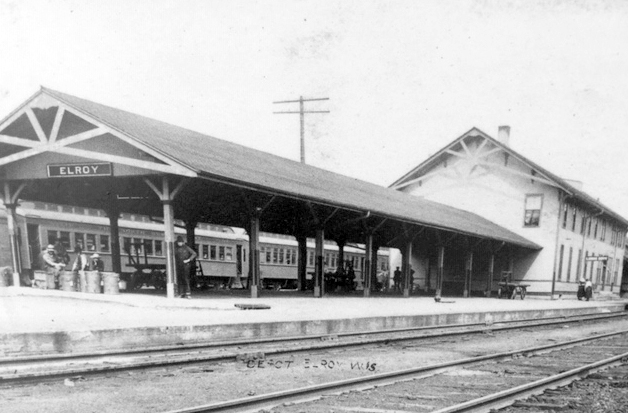Contributed by the Elroy Museum
On Aug. 5, 1872, the first train arrived in Elroy. To celebrate this historic event in Elroy’s history, the Elroy Museum will feature a number of displays from the early days of the railroad. Come visit the Elroy Museum on Elroy’s Main Street any Saturday or Sunday from 1–4 p.m. throughout the summer until Labor Day.

The sleepy community of Elroy was a slow-growing farming town when progress hit them with a big bang; the railroad was coming to town! Rumors of the railroad coming to Elroy had been around for four or five years when in 1869 the railroad line was agreed upon, placing Elroy at the center of the line between Chicago and Minneapolis.
The railroad history of Elroy started when the Chicago and Northwestern Railway (C&NW) reached Elroy from Reedsburg on Aug. 5, 1872, the West Wisconsin Railway reached Elroy from the north in December 1872, and the Winona and St. Peter Railway was built from the west, and by Jan. 5, 1873, through service from Chicago to St. Paul had been established. Elroy was growing in leaps and bounds. By 1872, the population doubled to 300, most of whom were in some way associated with the railroad. Many of these laborers were Irish, and many of them stayed in the Elroy area after the railroad was built. By 1874, the population was 600, and a real boom town was born. In 1905, the population peaked at 2,011, making it the largest city in Juneau County.
Picture Elroy in 1885 with the following stores:

contained the ticket office and the “Beanery” restaurant. Upstairs provided sleeping quarters for the railroad crews.
• Seven saloons
• Eight general stores
• One fancy-goods store
• Four hotels
• One barbershop
• One livery stable
• Two blacksmith shops
• One farm machinery shop
• One furniture store/undertaker
• Two meat markets
• One warehouse
• One doctor, one dentist, one lawyer
• Two shoemakers
• Six churches
• Two milliners
• Five dressmakers
• One painter
• One laundry
• One opera house
• One grist mill
Elroy remained a busy railroad hub for 80 years, often a political stop for Presidents (Hoover, Truman, Nixon), but after World War II rail, traffic declined due to other rail lines being built and the interstate system taking much of the shipping of commerce.

The round house and machine shop serviced trains from Chicago to Minneapolis for over 75 years. Note the 12 sets of tracks that allowed switching of trains. Up to 30 trains a day passed through Elroy during the peak years.
On July 23, 1963, the C&NW discontinued its passenger service through Elroy. The rail line west of Elroy to Sparta was abandoned in 1964, and freight continued to decline through Elroy in the 1970s and 1980s. Finally, on March 24, 1987, the last freight train was unloaded in Elroy, and on the following day, the train left Elroy with the empty cars as the church bells tolled the 6 p.m. hour, thus ending 115 years of railroading in Elroy.
To remind us of the many years of railroading in Elroy, the Elroy-Sparta Bike Trail was built in 1967, the 400 Bike Trail from Reedsburg to Elroy opened in the 1990s, and the Omaha Trail from Camp Douglas to Elroy was opened in 1992. These trails were built on the old rail lines connecting these communities. The Elroy Depot constructed in 1872–73 still stands and today serves as the Elroy Area Fire Department building.


